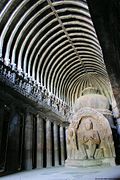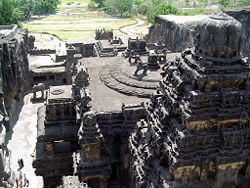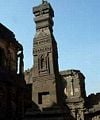Difference between revisions of "Ellora Caves" - New World Encyclopedia
Scott Dunbar (talk | contribs) m |
Scott Dunbar (talk | contribs) m |
||
| Line 1: | Line 1: | ||
| + | {{Images OK}} | ||
[[Image:Ellora7.JPG|thumb|right|200px|Jain cave in Ellora]] | [[Image:Ellora7.JPG|thumb|right|200px|Jain cave in Ellora]] | ||
| − | '''Ellora''' | + | The '''Ellora caves''' are monumental ancient Hindu, Jain, and Buddhist cave temples built in India between the 5th century and 10th century C.E... The "caves" – actually structures excavated out of the vertical face of the Charanandri hills – are located in the village of Ellora, India, situated 30 km (18.6 miles) from the city of Aurangabad in the state of Maharashtra. The cave temples represent the epitome of Indian rock cut [[architecture]] and have been declared a [[World Heritage Site]].<ref>{{cite web |
| − | |||
| − | |||
|url=http://whc.unesco.org/en/list/243 | |url=http://whc.unesco.org/en/list/243 | ||
|title=Ellora UNESCO World Heritage Site | |title=Ellora UNESCO World Heritage Site | ||
|publisher= | |publisher= | ||
|accessdate=Dec. 19, 2006 | |accessdate=Dec. 19, 2006 | ||
| − | }}</ref> | + | }}</ref> There are 35 caves at the site, which comprise of [[Buddhist]], [[Hindu]] and [[Jain]] [[temple]]s and [[monastery|monasteries]]. The 12 Buddhist (Caves 1-12), 17 Hindu (Caves 13-29) and 5 Jain caves (Caves 30-34), built in proximity, demonstrate the religious tolerance prevalent during this period of Indian history. |
==The Buddhist caves== | ==The Buddhist caves== | ||
[[Image:ellora cave10 002.jpg|thumb|right|120px|The "Carpenter's" cave]] | [[Image:ellora cave10 002.jpg|thumb|right|120px|The "Carpenter's" cave]] | ||
| − | The Buddhist caves | + | The Buddhist caves are the earliest structures, created between the fifth and seventh centuries. These consist mostly of ''[[Vihara|viharas]]'' (monasteries) and include large, multi-storeyed buildings carved into the mountain face, including living quarters, sleeping quarters, kitchens, and other rooms. |
| − | Some of these monastery caves have shrines | + | Some of these monastery caves have shrines depicting carvings of the [[Siddhartha Gautama|Buddha]], [[bodhisattva]]s and saints. In many of these caves, the original sculptors endeavored to give the stone a look of wood. |
| − | + | The most famous of the Buddhist caves is Cave #10, popularly known as the "Carpenter's Cave" (see picture inset). Beyond its multi-storeyed entry is a cathedral-like stupa hall also known as chaitya, whose ceiling has been carved to give the impression of wooden beams. At the heart of this cave is a 15 foot statue of Buddha seated in a preaching pose. | |
Amongst other Buddhsist caves, all of the first nine (caves 1-9) are monasteries. Each of the last two caves, Do Tal (cave 11) and Tin Tal (cave 12) has three stories. | Amongst other Buddhsist caves, all of the first nine (caves 1-9) are monasteries. Each of the last two caves, Do Tal (cave 11) and Tin Tal (cave 12) has three stories. | ||
| Line 43: | Line 42: | ||
== Pictures == | == Pictures == | ||
<gallery> | <gallery> | ||
| − | Image: | + | Image:Ellora cave16 003.jpg|Kailasanatha Temple, Ellora |
| − | Image:Ellora2a.JPG|Kailasanatha Temple | + | Image:Ellora2a.JPG|Kailasanatha Temple, Ellora |
| − | Image:Ellora | + | Image:Ellora1.JPG|Kailasanatha Temple, Ellora |
| + | Image:Ellora5.JPG|Kailasanatha Temple, Ellora | ||
Image:Ellora Kailash temple Nataraj painted panel.jpg|Kailash painted panel | Image:Ellora Kailash temple Nataraj painted panel.jpg|Kailash painted panel | ||
| − | |||
Image:Ellora cave12 001.jpg|Cave 12 | Image:Ellora cave12 001.jpg|Cave 12 | ||
| − | |||
| − | |||
</gallery> | </gallery> | ||
| − | |||
==Notes== | ==Notes== | ||
Revision as of 05:20, 16 April 2007
The Ellora caves are monumental ancient Hindu, Jain, and Buddhist cave temples built in India between the 5th century and 10th century C.E... The "caves" – actually structures excavated out of the vertical face of the Charanandri hills – are located in the village of Ellora, India, situated 30 km (18.6 miles) from the city of Aurangabad in the state of Maharashtra. The cave temples represent the epitome of Indian rock cut architecture and have been declared a World Heritage Site.[1] There are 35 caves at the site, which comprise of Buddhist, Hindu and Jain temples and monasteries. The 12 Buddhist (Caves 1-12), 17 Hindu (Caves 13-29) and 5 Jain caves (Caves 30-34), built in proximity, demonstrate the religious tolerance prevalent during this period of Indian history.
The Buddhist caves
The Buddhist caves are the earliest structures, created between the fifth and seventh centuries. These consist mostly of viharas (monasteries) and include large, multi-storeyed buildings carved into the mountain face, including living quarters, sleeping quarters, kitchens, and other rooms.
Some of these monastery caves have shrines depicting carvings of the Buddha, bodhisattvas and saints. In many of these caves, the original sculptors endeavored to give the stone a look of wood.
The most famous of the Buddhist caves is Cave #10, popularly known as the "Carpenter's Cave" (see picture inset). Beyond its multi-storeyed entry is a cathedral-like stupa hall also known as chaitya, whose ceiling has been carved to give the impression of wooden beams. At the heart of this cave is a 15 foot statue of Buddha seated in a preaching pose.
Amongst other Buddhsist caves, all of the first nine (caves 1-9) are monasteries. Each of the last two caves, Do Tal (cave 11) and Tin Tal (cave 12) has three stories.
The Hindu caves
The Hindu caves were constructed in the beginning of the 7th century and represents a different style of creative vision and execution skills. These temples were carved from top to down. Some were of such complexity that they required several generations of planning and coordination to complete.
Cave 16, called The Kailasa or Kailasanatha Temple, is the unrivalled centerpiece of Ellora. This gargantuan structure – designed to recall Mount Kailash, the abode of Lord Shiva – looks like a freestanding, multi-storeyed temple complex, but it was carved out of one single rock, and covers an area double the size of Parthenon in Athens.
All the carvings are done in more than one level. A two-storeyed gateway opens to reveal a U-shaped courtyard. The courtyard is edged by columned galleries three storeys high. The galleries are punctuated by huge sculpted panels, and alcoves containing enormous sculptures of a variety of deities. Originally flying bridges of living stone connected these galleries to central temple structures, but these have fallen.
Within the courtyard are two structures. As is traditional in Shiva temples, an image of the sacred bull Nandi fronts the central temple housing the lingam. In Cave 16, the Nandi Mandap and main Shiva temple are each about 7 meters high, and built on two stories. The lower stories of the Nandi Mandap are both solid structures, decorated with elaborate illustrative carvings. The base of the temple has been carved to suggest that elephants are holding the structure aloft.
A living rock bridge connects the Nandi Mandap to the porch of the temple. The temple itself is tall pyramidic structure reminiscent of a South Indian temple. The shrine – complete with pillars, windows, inner and outer rooms, gathering halls, and an enormous lingam at its heart – carved from living stone, is carved with niches, plasters, windows as well as images of deities, mithunas (erotic male and female figures) and other figures. Most of the deities at the left of the entrance are Shaivaite (followers of Lord Shiva) while on the right hand side the deities are Vaishnavaites (followers of Lord Vishnu).
There are two Dhvajastambhas (pillars with the flagstaff) in the courtyard. The grand sculpture of Ravana attempting to lift Mount Kailasa, the abode of Lord Shiva, with his full might is a landmark in Indian art.
The construction of this cave was a feat of human genius – it entailed removal of 200,000 tonnes of rock, took 100 years to complete.
"The temple is a splendid achievement of Dravidian art. This project was started by Krishna I (757- 773) of the Rashtrakuta dynasty that ruled from Manyakheta in present day Karnataka state. His rule had also spread to southern India, hence this temple was excavated in the prevailing style. Its builders modelled it on the lines of the Virupaksha Temple in Pattadakal. Being a south Indian style temple, it does not have a shikhara common to north Indian temples". - The Guide to the Architecture of the Indian Subcontinent, 1996, Takeo Kamiya, Japan Architects Academy and Archeological Survey of India
Other notable Hindu caves include the Dasha Avatara cave (cave 15), which depicts the 10 incarnations of Vishnu, the Ramesvara cave (cave 21) which has figurines of river goddesses at the entrance and the Dhumar Lena (cave 29) whose design is similar to the cave temple on Elephanta Island in Mumbai.
The Jain caves
Jain caves reveal specific dimensions of Jain philosophy and tradition. They reflect a strict sense of asceticism – they are not relatively large as compared to others, but they present exceptionally detailed art works. For example, the 32nd cave, Indra Sabha is a shrine with a very fine carving of the lotus flower on the ceiling. In another cave, an imposing yakshi is seated on her lion under a mango tree, laden with fruits. All other Jain caves are also characterised by intricate detailing. Many of the structures had rich paintings in the ceilings - fragments of which are still visible.
Pictures
- Ellora1.JPG
Kailasanatha Temple, Ellora
- Ellora5.JPG
Kailasanatha Temple, Ellora
Notes
- ↑ Ellora UNESCO World Heritage Site. Retrieved Dec. 19, 2006.
ReferencesISBN links support NWE through referral fees
- Takeo Kamiya, The Guide to the Architecture of the Indian Subcontinent, Japan Architects Academy and Archeological Survey of India, 1996.
External links
- Description on Kailash Temple Retrieved April 13, 2007.
- Ellora Caves in UNESCO List Retrieved April 13, 2007.
- Pictures of Ellora from india-picture.net Retrieved April 13, 2007.
- Pictures of Ellora and other rock cut caves Retrieved April 13, 2007.
Credits
New World Encyclopedia writers and editors rewrote and completed the Wikipedia article in accordance with New World Encyclopedia standards. This article abides by terms of the Creative Commons CC-by-sa 3.0 License (CC-by-sa), which may be used and disseminated with proper attribution. Credit is due under the terms of this license that can reference both the New World Encyclopedia contributors and the selfless volunteer contributors of the Wikimedia Foundation. To cite this article click here for a list of acceptable citing formats.The history of earlier contributions by wikipedians is accessible to researchers here:
The history of this article since it was imported to New World Encyclopedia:
Note: Some restrictions may apply to use of individual images which are separately licensed.






